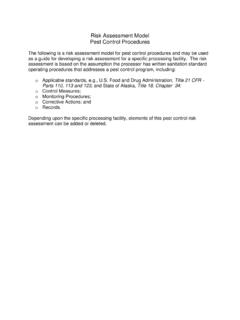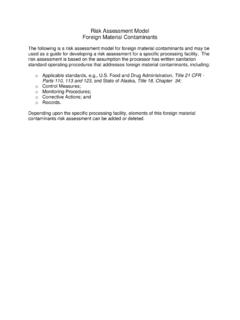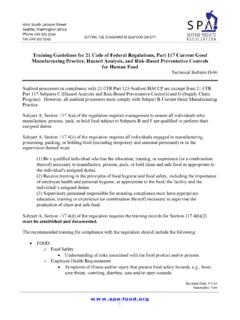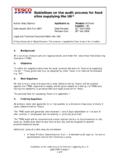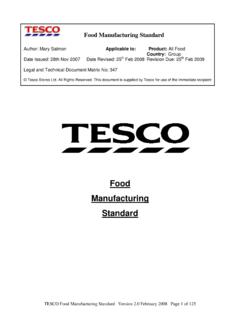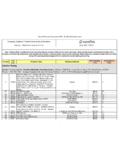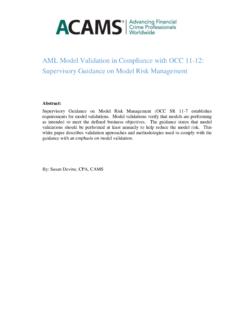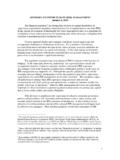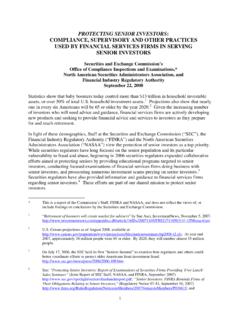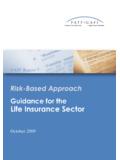Transcription of Risk Assessment Model Employee Services
1 Risk Assessment Model Employee Services The following is a risk Assessment Model for Employee Services and may be used as a guide for developing a risk Assessment for a specific processing facility. The risk Assessment is based on the assumption the processor has written sanitation standard operating procedures that addresses Employee Services , including: o Applicable standards, , Food and Drug Administration, Title 21 CFR - Parts 110, 113 and 123, and State of Alaska, Title 18, Chapter 34; o Control Measures; o Monitoring Procedures; o Corrective Actions; and o Records.
2 Depending upon the specific processing facility, elements of this Employee Services risk Assessment can be added or deleted. Risk Assessment Model Employee Services Risk Assessment - Potential Hazard Identification: Employee s personal clothing and protective clothing ( , smocks) issued by the processor may be a source of contaminants that could be transferred into the processing plant and potentially contaminate food, food contact surfaces, and packaging materials if established procedures and good manufacturing practices are not followed.
3 Risk Assessment - Hazard Characterization: Title 21, Code of Federal Regulations Part 110 Good Manufacturing Practices (GMPs) states (Section [b][1]): All persons working in direct contact with food, food-contact surfaces, and food-packaging materials shall conform to hygienic practices while on duty to the extent necessary to protect against contamination of food. The methods for maintaining cleanliness include, but are not limited to: Wearing outer garments suitable to the operation in a manner that protects against the contamination of food, food-contact surfaces, or food-packaging materials.
4 Contaminants could enter the processing facility and constitute a potential risk if employees do not follow established written procedures and GMPs. Risk Assessment Exposure Assessment : All areas of the processing plant are potentially exposed to contaminants transported by Employee s personal clothing and protective clothing ( , smocks) issued by the processor. The greatest concern is in sensitive areas of the processing facility where food, food contact surfaces, and packaging materials are exposed, including can cooling areas.
5 Risk Assessment Model Employee Services Page No. 2 Risk Assessment Risk Characterization: Severity High Contamination with hazardous foreign material Medium Contamination with non-hazardous foreign material Low Aesthetic only, no food safety concern High - Likely to happen over the course of a season High Medium Low Medium - Has been know to happen High Medium Low Likelihood Low - Not likely to occur but possible Medium Low Low Risk Assessment Model Employee Services Page No. 3 The risk Assessment covers the procedures for Employee s personal and protective clothing ( , smocks), and procedures for handling the items.
6 Hazard* Risk Reason Ineffective cleaning resulting in fish residue remaining on clothing Low Ineffective removal of bacteria from clothing due to non-use of soap provided Low 1. Employees are required to machine wash smocks 2. Guidance for effective washing of smocks is distributed to employees 3. In-house laundering service is available 4. Cleanliness of smocks and their removal is monitored continuously Ineffective stain removal from clothing Low Not a food safety hazard Smock not ironed Low Not a food safety hazard Contamination from household pets on clothing Low Inappropriate use of smocks off-premises Low Contamination due to wearing smocks off premises Low Contamination from car or bus seats in transit to work Low 1.
7 Employees are not permitted to wear smocks off-site 2. Employees may not don smocks until arrival at the plant 3. Cleanliness of smocks and their removal is monitored continuously * Foreign material hazards from clothing are covered under a separate Foreign Material Risk Assessment . Example is for a facility that does not have allergenic materials other than fishery products. Risk Assessment Model Employee Services Page No. 4 Risk Management: Overall, the potential risk of contamination associated with Employee s personal and issued clothing is low under normal operating conditions.
8 Enforcing the basic GMPs and established written policies are adequate means to prevent contamination of food, food contact materials, and packaging materials, provided: o Protective clothing ( , smocks) is issued to employees; o Employees are instructed on GMP s, proper procedures for caring and wearing of protective clothing, as well as personal clothing; o Facilities are made available for employees to wash clothing, both personal and protective clothing; o Guidance is given to employees regarding proper washing procedures; o Approved soap is made available to employees for washing clothing; o Protective clothing is maintained in good repair, and changed when it becomes contaminated or excessively soiled; and o Employee practices are continuously monitored by supervisory and quality control staff.
9 In addition, customer complaints shall be reviewed and evaluated for potential problems associated with Employee procedures, and corrective action taken as deemed appropriate. Risk Communication: The established written policies and GMP s must be communicated to the employees--- especially those working in the sensitive areas of the processing facility---during pre-season Employee training. Where appropriate, signage may be posted to emphasize the policies and GMP s. As warranted, the established procedures shall be discussed with individuals when infractions occur to ensure compliance with the policies, and discipline action taken if necessary.
10
